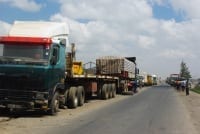The new democratic dispensation in Kenya has produced an enabling climate for infrastructure development.
The first economic development policy that came out of the National Rainbow Coalition Government in 2002 had a strong focus on infrastructure development, driven by political promises with emphasis on road development, developing ports and all channels of communication and transport. This policy was followed by Vision 2030, a long-range development plan that emphasised infrastructure development. The new 2010 Kenyan Constitution reflected aspects of infrastructure development. By introducing a devolved system of government characterised by decentralised budgeting and planning, communities were given control over local planning priorities that included infrastructure planning. The Constitution also provided for an Equalisation Fund that provided infrastructure funding for areas in Kenya that were marginalised by previous governments or regimes. With the evolution of planning to the local levels, the National Government can focus on large mega projects such as the Lamu Port Southern Sudan–Ethiopia Transport (LAPSSET) Corridor project. From the outset of the LAPSSET project, leadership of Kenya, Uganda, South Sudan and Ethiopia were involved owing to the regional importance of this project. The LAPSSET project was approved as an important continental infrastructure project under the Nepad Programme for Infrastructure Development in Africa (PIDA) in June 2015. NEPAD considers the LAPSETT project and its key components as the key infrastructure for the East and Central Africa region. The LAPSSET Project involves seven infrastructure components. From the start the project involved the strong participation of the private sector investment partners chiefly because national government could not fund this project alone. One of the key components of the LAPSSET Corridor project is the development of the Lamu Port, with the aim of developing 32 deep-sea berths off the East African coast by 2018. The intention is that these berths will create a new niche of port services along the East African coast. These berths will be designed by the China Communications Construction Company that won the construction tender.Private sector participation has been important in driving the LAPSSET Corridor forward and plans are already underway with developing six to nine berths in Lamu with private sector funding assistance and collaboration from development partners such as Development Bank of South Africa. Along with the development of Lamu Port is the planned construction of a 1 000MW coal power plant in Lamu that will facilitate the development of a coal handling facility at the port.
The road to the Port of Lamu, financed by the World Bank to the tune of $500 million, is another component of the LAPSSET project. The road, which is 508 km’s long, is being constructed on the Kenyan side of the corridor project from Isiolo to the border with Ethiopia. At the same time, Ethiopia is building a 498 km road on its side that will open road access to Addis Ababa from Lamu. In addition, an immediate road connection is already being built between Lamu and the existing B9 road to service the port from the land side. The construction of an oil pipeline in Lamu is meant to facilitate the flow of oil from South Sudan and Uganda to be exported through the port. It is expected that the pipeline will be completed in under five years’ time. The construction of the oil refinery at Lamu will facilitate the processing of crude oil from South Sudan and Uganda. The LAPSSET project is a catalytic project that will open up several economic opportunities in the Northern part of Kenya. In addition, the Kenyan government plans to build nine additional cities in addition to the resort cities present in the Northern part of Kenya, as well as three international airports (Turkana, Isiolo and Lamu) for this region. All of these investments will open up the hinterland for massive economic development opportunities, in the medium to long term. The current progress and success of the LAPSSET programme is built on the back of both the private and public sectors. In managing projects like LAPSSET it is important to have a large degree of predictability and flexibility as the project develops. Currency exchange rates can fluctuate due to changes in the capital markets cause by volatility in global markets. In this case, it is important for projects like the long term LAPSETT corridor project to acquire a strategic ‘financing mix’ of traditional and non-traditional funding sources in order to be financially viable and stable.







